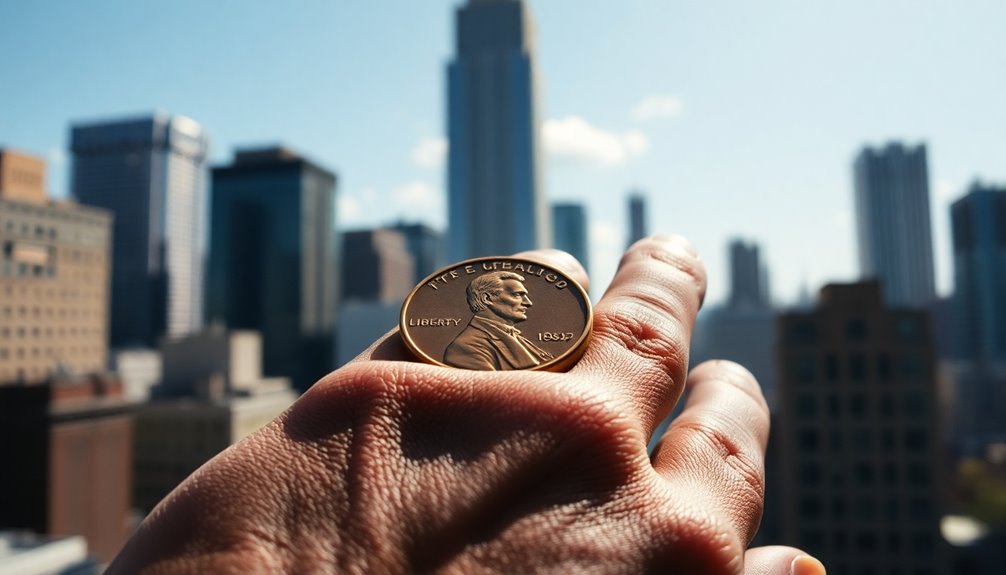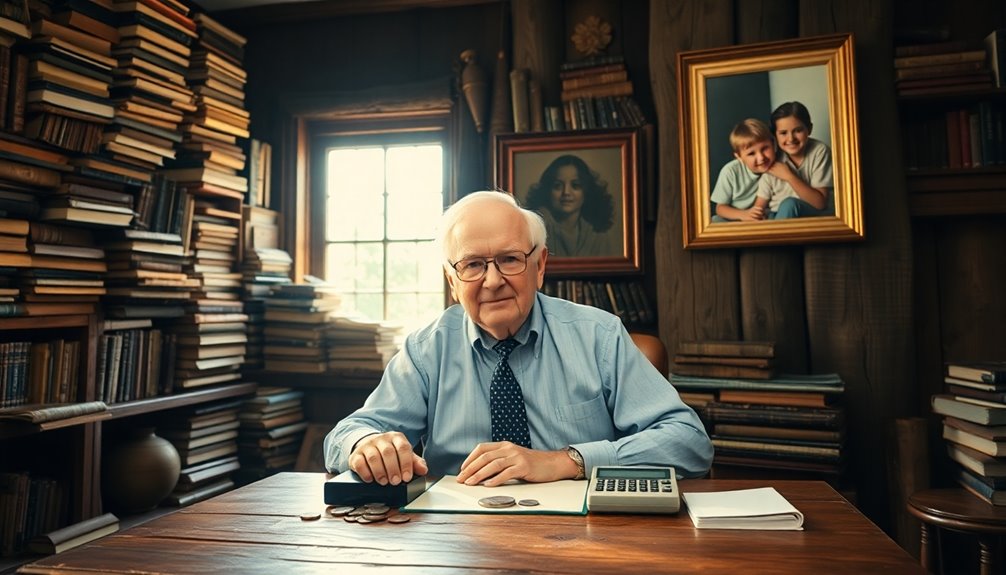Warren Buffett's billionaire blueprint combines savvy investing with a long-term mindset. He started early, turning simple childhood investments into millions by consistently seeking undervalued companies with strong growth potential. His strategy emphasizes resilience, focusing on companies with a competitive edge and high-quality management. Despite facing setbacks, including significant losses during the 2008 crisis, Buffett always bounced back, investing strategically in financially strong firms. Living modestly, he prioritizes thoughtful spending and philanthropy, pledging to give away over 99% of his wealth. If you're curious about the finer details of his approach and values, there's much more to uncover.
Key Takeaways
- Warren Buffett's value investing strategy focuses on identifying undervalued companies with strong growth potential and a durable competitive advantage.
- He emphasizes long-term returns, leveraging compound interest while ignoring short-term market fluctuations and focusing on intrinsic value.
- Buffett's early entrepreneurial spirit and early investments helped him accumulate wealth rapidly, reaching $1 million by age 30.
- His disciplined lifestyle and spending habits prioritize necessary expenses, allowing him to reinvest profits into growing his wealth.
- Committed to philanthropy, Buffett has pledged over 99% of his wealth to charitable causes, ensuring a legacy of impactful giving.
Introduction

In the world of investing, clarity is key, and Warren Buffett's approach offers a masterclass in financial wisdom. You'll find that Buffett emphasizes value investing, identifying undervalued companies with strong growth potential for the long term. His focus on long-term returns allows you to ignore short-term market fluctuations, leveraging the power of compound interest. To gauge a company's worth, he establishes its intrinsic value by projecting future earnings and discounting them back to present-day levels.
Buffett seeks businesses with a durable competitive advantage—a "moat" that protects them from competitors. He prioritizes high-quality management, valuing ethical leadership and transparency. His investment strategy evolved from the "cigar butt" approach to seeking wonderful businesses at fair prices, influenced by his partner, Charlie Munger. Instead of over-diversifying, Buffett concentrates on a select number of high-quality stocks, maintaining cash reserves for opportunistic investments during market downturns. This strategy reflects his emphasis on long-term economic sustainability as a core investment criterion.
With a long-term holding period in mind, he embraces a circle of competence, investing only in what he understands. By aligning with these principles, you can navigate the complexities of investing with confidence, just like Buffett does.
Early Life and Background

Many factors shaped Warren Buffett's early life and laid the groundwork for his future success. Born on August 30, 1930, in Omaha, Nebraska, he grew up in a comfortable family as the only son of Leila and Congressman Howard Buffett. While his family wasn't exceptionally wealthy, his father's career as a stockbroker sparked Buffett's early interest in finance.
Buffett's education began at Rose Hill Elementary School and continued through various schools, culminating in his graduation from Woodrow Wilson High School in 1947. He later enrolled at The Wharton School before transferring to the University of Nebraska, where he earned a B.S. in Economics in 1950. In 1951, he graduated with a Bachelor of Science in business administration.
From a young age, he displayed entrepreneurial spirit by working at his grandfather's grocery store and filing his first income tax return at just 13. At age 11, he bought shares of Cities Service Preferred, marking the start of his investment journey. By 15, he delivered newspapers, earning over $175 monthly, which helped him accumulate $9,800 in savings by the time he finished college. These early experiences laid a solid foundation for his future as a legendary investor.
Estimated Net Worth

As Warren Buffett's career progressed, his net worth saw remarkable growth, reflecting his investment acumen and strategic decisions. At age 30, you'd find him worth $1 million, a figure that skyrocketed to $26 million by age 35 through successful partnerships. By 39, his net worth stabilized at $25 million, but faced a dip to $19 million at 44 due to financial troubles.
However, Buffett rebounded impressively. By age 47, his net worth climbed to $67 million, and in 1983, he officially became a billionaire with a remarkable $620 million. Fast forward to age 60, and his wealth surged to $3.8 billion. By 66, he was worth an astounding $16.5 billion.
As of July 2024, his net worth reached $137.4 billion, and by December 2024, it grew to $150.6 billion, making him the 8th richest person in the world. Notably, approximately 88% of his wealth has been generated since turning 65. Today, you can see significant stakes in major companies like Bank of America, Apple, American Express, and Coca-Cola, underscoring his status as a financial titan.
Buffett's early years laid the groundwork for his future success, as he started with a net worth of nearly $20,000 at age 21.
Lifestyle and Spending Habits

Buffett's staggering wealth hasn't led him to a lifestyle filled with luxury and extravagance; instead, he embodies a frugal and grounded approach to living. You'll find him residing in the same Omaha house he bought in 1958 for just $31,500, eschewing major renovations. His choice of transportation? Ordinary, slightly used cars that he drives for as long as possible.
When it comes to meals, he sticks to a budget, often spending no more than $3.17 on breakfast. Even as a billionaire, he still uses coupons and favors cash over credit to avoid high-interest debt. Buffett distinguishes between wants and needs, prioritizing necessary expenses and living modestly. He once used a $20 flip phone until 2020, showcasing his lack of interest in luxury items. Additionally, his home features security cameras to maintain safety while he enjoys a simple lifestyle.
Buffett tracks his expenses meticulously, understanding where every dollar goes. He believes in buying quality goods that last and prefers home-cooked meals over dining out. By avoiding unnecessary subscriptions and focusing on value-based spending, he exemplifies financial discipline that anyone can learn from.
Investment in Berkshire Hathaway

Berkshire Hathaway stands as a towering example of Buffett's investment acumen and philosophy. Formed through the merger of Diversified Retailing and Blue Chip Stamps, this company arose from the need to streamline operations amidst SEC investigations and the complexities of managing multiple holdings. When Charlie Munger swapped his shares for 2% of Berkshire, he became Vice Chairman, setting the stage for a unique investment strategy.
Buffett's approach emphasizes acquiring well-managed businesses with a strong economic moat. He seeks companies with competitive advantages like cost efficiencies, patents, or brand loyalty. By focusing on firms with solid management and a history of steady growth, Buffett ensures he buys good companies at the right price, allowing for long-term appreciation. His strategy has evolved over the years, incorporating insights from his early investments to refine his investment criteria.
Berkshire Hathaway's investment horizon is notably long-term, often described as "forever." This strategy enables the compounding of returns and fosters substantial growth over time. Buffett prioritizes ethical leadership and prefers blue-chip stocks, all while maintaining cash reserves to capitalize on undervalued opportunities during market fluctuations. By sticking to these principles, you can see how Berkshire Hathaway embodies Buffett's disciplined investment philosophy.
Multiple Business Ventures

Throughout his career, Warren Buffett has ventured into a variety of businesses, showcasing his adaptability and keen investment instincts. You'll notice that he started investing at just 11, running a paper route at 13 and selling horse racing tip sheets as a young entrepreneur. By the late 1950s, he formed investment partnerships, including Buffett Partnership Ltd. in 1956, and expanded to six partnerships by 1959.
Buffett took an activist role in his investments, notably in Sanborn Map Company, where he acquired shares at $45 each, despite their portfolio value being $65. He gained a board seat, influencing significant decisions like share repurchases. His ventures didn't stop there. He diversified from textiles to insurance with Berkshire Hathaway and became the largest shareholder in Salomon Inc. in 1987.
He also made strategic acquisitions, such as Burlington Northern Santa Fe Corp. for $34 billion in 2009, showcasing his commitment to diversification. With significant holdings in both private and public companies, Buffett consistently seeks investments with strong competitive advantages, ensuring long-term returns on capital. This multifaceted approach has been central to his success, as he emphasizes understanding the business before making any investment decisions.
Investment in Coca-Cola

In 1988 and 1989, Warren Buffett made a bold move by investing over $1 billion in Coca-Cola, seizing the opportunity following the 1987 stock market crash. He recognized Coca-Cola's strong brand and competitive edge, believing it would thrive under the leadership of Roberto Goizueta and Donald Keough. Buffett purchased the shares at attractive valuations—15 times earnings and 12 times cash flow—making it the largest position in Berkshire Hathaway's portfolio. This investment exemplified Buffett's principle of "buying quality", focusing on companies that demonstrate resilience and long-term potential.
Buffett intended to hold these shares indefinitely, reflecting his long-term investment philosophy. With Coca-Cola's international growth potential, particularly in emerging markets, he saw an opportunity for significant returns. Under Goizueta's management, the company's return on equity soared to 31% by 1988, showcasing improved profit margins due to cost optimization.
Investment Losses in 2008

Buffett's investment strategy faced significant challenges during the tumultuous financial crisis of 2008. The global economy was in turmoil, and credit markets had seized up. Yet, you might find it interesting that Buffett seized this opportunity to make bold investments. He invested $3 billion in General Electric's preferred stock in October 2008, earning a 10% dividend and including stock warrants as part of the deal. By October 2011, GE redeemed the preferred stock for $3.3 billion, netting Berkshire Hathaway a $1.5 billion profit. This investment was seen as a vote of confidence in GE's future during a period of uncertainty. Additionally, Buffett's decisions reflected his understanding of long-term investment principles, which often lead to profitable outcomes despite market fluctuations.
Similarly, Buffett invested $5 billion in Goldman Sachs with special preferred shares that also paid a 10% annual dividend. Goldman repaid this investment in March 2011, plus a one-time $500 million dividend. Despite the market conditions, these strategic moves resulted in a remarkable return, with total profits from crisis-era deals estimated at $10 billion and counting. It's worth noting that while Buffett's net worth dropped by $11.5 billion in 2008, he maintained a long-term perspective that ultimately paid off, proving that even in a crisis, strategic investing can lead to substantial gains.
Charitable Pledges and Foundations

Charitable pledges have become a hallmark of Warren Buffett's legacy, showcasing his commitment to philanthropy. Since announcing his pledge in 2006, Buffett has directed significant resources to various foundations, with the Bill & Melinda Gates Foundation receiving nearly $39.3 billion. His other contributions include almost $4.2 billion to the Susan Thompson Buffett Foundation, focusing on education and reproductive health rights, and over $2.4 billion each to the Howard G. Buffett Foundation, the Sherwood Foundation, and the NoVo Foundation. In 2022 alone, the Gates Foundation deployed $7 billion towards crucial global health initiatives.
Buffett's structured giving involves annual payments of 5% of his promised shares to the Gates Foundation, with specific conditions regarding its leadership. His historic pledge not only made him the largest donor in history but also triggered a transformative shift in the philanthropic landscape, shaping public conversations on giving.
He's committed to donating over 99% of his wealth during his lifetime, while the remaining funds will be managed by his children through a charitable trust after his passing. With transparency at the forefront, Buffett plans to make his will public, ensuring clarity in his philanthropic legacy.
Sustainable Investing Trends Ahead

As we look ahead, sustainable investing is rapidly evolving, driven by a combination of regulatory changes, technological advancements, and shifting investor sentiment. You'll notice that regulatory bodies worldwide are implementing stringent disclosure requirements, promoting greater transparency. This means you can make informed investment choices that align with your values, as standardized reporting on sustainability factors becomes more common. With tighter definitions of sustainable investments, the risk of greenwashing is decreasing.
Technological integration plays a significant role too. Artificial intelligence and big data analytics will allow you to evaluate companies' sustainability efforts in real time, giving you insights into long-term viability. This fusion of finance and technology will enhance your ability to build and manage sustainable portfolios more efficiently. Moreover, advanced tools will empower investors to navigate the complexities of sustainability challenges effectively.
On a larger scale, sustainable investment assets are expected to continue their growth trajectory, with $30.3 trillion currently invested globally. Interestingly, over half of individual investors plan to increase their allocations to sustainable investments in 2024. With a focus on climate action, healthcare, and water solutions, you'll find that more investors consider a company's carbon footprint when making decisions. The future of sustainable investing is bright and full of potential.
Legacy of Philanthropy and Wisdom

A legacy of philanthropy and wisdom defines Warren Buffett's approach to giving back. Since 2006, you've seen him pledge over $36 billion in Berkshire Hathaway shares to the Bill & Melinda Gates Foundation, alongside significant contributions to family foundations. His total donations have reached an astonishing $50.7 billion, reflecting a commitment to make a lasting impact. In fact, his donations have resulted in a significant reduction of Class A shares by 56.6% since 2006.
Buffett believes in responsibility over excess. He aims to leave his children enough to thrive but not so much that they lack purpose. This philosophy guides his philanthropic strategy, promoting efficient use of funds while encouraging his family to actively participate in decision-making. By co-founding The Giving Pledge with the Gates, he inspires fellow billionaires to commit a substantial portion of their wealth to charity.
Buffett's transparency is noteworthy; he details his donations publicly and plans to reveal his will after his passing. With over 99% of his estate allocated for philanthropic efforts, he sets a clear example of how wealth can be used to foster global health, education, and social justice. His legacy is not just in the money he gives but in the principles that guide his generosity.
Frequently Asked Questions
What Strategies Does Buffett Recommend for Beginner Investors?
For beginner investors, start by investing early to harness the power of compound interest. Focus on industries you understand well, conducting thorough research before committing. Adopt a long-term hold strategy, treating the market as a means for steady growth rather than quick gains. Prioritize value investing by buying strong companies at fair prices, and always maintain a margin of safety. Remember, it's crucial to avoid losses and stay patient for substantial rewards.
How Has Buffett's Investment Philosophy Evolved Over the Years?
Buffett's investment philosophy has evolved significantly over the years. Initially, you'd see him focusing on undervalued companies, employing the "cigar butt" approach. As he gained experience, he shifted to analyzing businesses, emphasizing intrinsic value and competitive advantages. You'd notice his growing appreciation for intangible assets, like brands and management quality. Today, he advocates for long-term investments, leveraging the power of compounding while maintaining a strict circle of competence to ensure sustainable growth.
What Books or Resources Does Buffett Suggest for Financial Education?
If you're looking to enhance your financial education, Warren Buffett recommends several key books. Start with The Intelligent Investor by Benjamin Graham, which emphasizes value investing principles. Next, check out Security Analysis for a deeper understanding of investment analysis. For broader business insights, read Business Adventures by John Brooks. Lastly, The Essays of Warren Buffett provides valuable lessons from Buffett's own experiences and investment philosophy. These resources can significantly boost your financial acumen.
How Does Buffett Approach Risk Management in Investing?
When you think about risk management in investing, focus on your time horizon. Short-term trades can be risky, while long-term investments tend to reduce that risk. Stick to businesses you understand well, researching their financials and competitive advantages. Look for a margin of safety in stock purchases and invest in companies with durable competitive advantages. Concentrate your portfolio on a few strong businesses instead of diversifying too broadly; this enhances your investment's potential.
What Personal Habits Contribute to Buffett's Success?
You'll find that personal habits play a crucial role in your success. Start your day early, maintain a consistent routine, and prioritize sleep. Cultivate discipline by saying no to distractions that don't align with your goals. Dedicate time for deep analysis and reading to enhance your critical thinking. Embrace simplicity and frugality in your lifestyle, focusing on value over extravagance. These habits can help you achieve long-term success in any endeavor.










